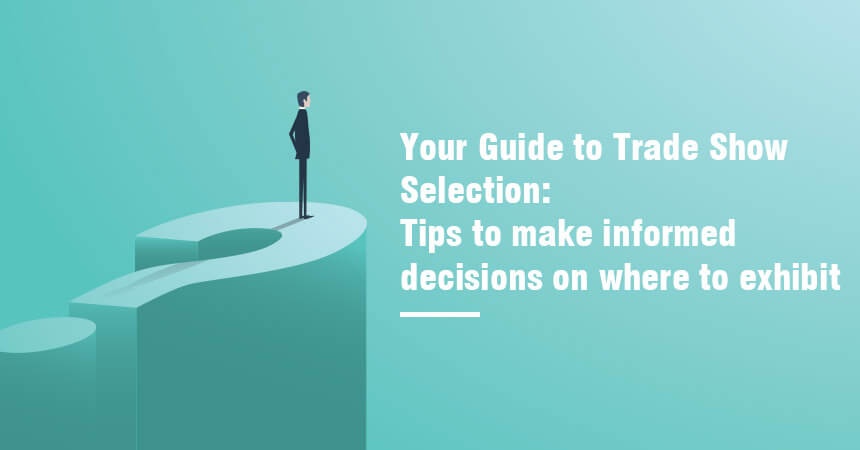
Your Guide to Trade Show Selection. Tips to make informed decisions on where to exhibit
Your exhibit program requires you to make hundreds of decisions. The most fundamental decisions of all are which shows are worthy of your investment. Ideally, you only exhibit at shows that will give you the most significant impact.
This guide will help you develop a strategy to choose which shows will do just that. You’ll find that all it takes is a little bit of planning, consideration of your audience, and asking the right questions.
This guide is divided into 5 phases. We recommend utilizing each, and in the order presented, to develop a holistic strategy for show selection.
Phase #1: Determine Your Objectives
Before putting any energy into searching, spend some time to determine your objectives for exhibiting. This should always be the first step as it sets the stage for your search. Some objectives might be:
- Increase brand awareness
- Increase leads and/or sales
- Launch a new product or service
- Promote brand as an innovative industry leader
- Strengthen relationships with existing customers
- Perhaps a combination of the above
To determine objectives, survey, or interview internal departments. Maybe you find out from your sales team that you have an underperforming product in your company’s portfolio. Shows with a target audience for that item would solve that problem.
Perhaps you find out from management that a key company objective is to become a thought leader in the industry. Shows with speaking opportunities would solve that problem.
Perhaps you find out that sales and marketing are aligned on the goal of increasing visibility. A large number of shows with smaller, budget-friendly booths would solve that problem.
The point here is to have your company’s objectives initiate your trade show selection process.
 Phase #2: Consider Your Audience
Phase #2: Consider Your Audience
With your objectives in mind, shift your focus to your audience. Their needs and expectations need to be met to craft a positive experience with your brand. Considerations include:
Location: With half of a show’s attendees likely coming from a 200-mile radius, location significantly affects a show’s potential.
Accessibility: Ideally, your audience can easily arrive at the venue from a variety of transportation methods, and parking or valet is straightforward.
Lodging Accommodations: If the venue is not located within a hotel, ideally there are options within walking distance. If there are not, look into shuttle, taxi, or car services.
Ambiance: Every physical aspect of the venue will be a factor in your attendees’ experience. Consider the parking garages, the outside architecture, inside décor, entranceways, and even the restrooms.
Miscellaneous: Other considerations might include the quality of the venue’s Wi-Fi, the quality of food served at the event (or that you cater), and the availability of nearby restaurants and other attractions if your audience engagement spills out of the venue.
Phase #3: Create a Master List of Shows
With brand objectives and the needs of your audience considered, start building out a master list of possible shows to attend. Include shows you have previously attended, ones that have come up in conversation, and any that came up in outside research such as competitor websites or search engines.
Here are a few popular search engines for the exhibition industry:
1. Trade Show News Network
2. ExpoDataBase
3. EventsEye
4. Trade Show Calendar
We recommended keeping in mind that these sites might not be entirely accurate, for a variety of reasons. Use them to build out your list of possible shows, but not necessarily to eliminate shows from your list.
Add your developing list of shows to a spreadsheet where you can also include details such as the growth or decline of a show, competitor presence if prospective clients plan to attend, and any data you get from interviewing show management and analyzing the event in the next phases.
 Phase #4: Interview Show Management
Phase #4: Interview Show Management
Show management can offer loads of information, but in most cases, you must ask for it. As an exhibitor, you will typically only receive a show prospectus containing options, deadlines, rules, and service order forms.
Here are four topics you should consider discussing with show management to help bolster the details you will add to your spreadsheet of prospective shows.
Successful strategies at the show: Show management should have a unique perspective on what works (and what doesn’t) at their show. If your rep can’t offer any successful strategies, they are either out of touch with the show, or particular tactics don’t seem to work. If management is clueless, chances are they are not concerned with or aware of what exhibitors are doing. If that is the case, you will be on your own in developing a successful strategy, and that show might not be the best option.
Promotion for the show: Show management should be deploying promotional strategies throughout the year to ensure the event is well attended. When you sign up for exhibit space, you are essentially investing in this promotional service. Be sure what you are paying for is delivered on. If management’s level of interaction is high, you might inquire about how your company can get involved.
Sponsorship opportunities: Show management will likely have a long list of sponsorships to choose from. The question to ask is which ones align with your objectives – better yet, which ones can be customized to your goals. Management is not expected to be completely accommodating here. If they are unwilling to assist, likely, they care more about revenue than your needs and you should take your business elsewhere.
Insight on competitors: Show management should be able to tell you where your competitors will be and the size of their booths. And beyond successful strategies implemented in the past, they might be able to tell you your competition’s presentation schedules and traffic-building activities. This information can help you develop your strategy for location – either intentionally close to competition to funnel traffic to your trade show booth or deliberately placing yourself far away from heavy competition.
Bottom line: the degree of helpful and competent show management is should be a data point for your spreadsheet.
Phase #5: Analyze the Event
This step involves gathering some analytical data which can pair with the information you’ve collected from previous phases to start determining if a show is a good fit or not.
The first variable to know is the show’s potential audience. Show management might offer you gross attendance, but at least 34% of that figure will be exhibitors. The better figure is net attendance where exhibitors have been subtracted out.
The next variable to figure is traffic density, which is the number of attendees occupying every 100 square feet of show-floor space throughout the event. Traffic density can be calculated by multiplying net attendance by the average number of hours attendees will spend on the floor (9 hours being a safe guess) and then multiplying by 100.
There are many more variables that can be calculated and added to your spreadsheet. These two variables are a good starting point and will help highlight certain shows and eliminate others.
 Bonus Tip: Go to the Show Yourself
Bonus Tip: Go to the Show Yourself
We could have named this phase 5, but instead, it is included as a tip because not everyone will be able to utilize this tactic.
Researching prospective shows online might be all you need to develop a strong list of shows. But if you need to go further, the best and most telling information you can get is by attending a show in person.
Walk the floor, talk to show management, and exhibitors in person. And take it one step further and check out the surrounding area of the venue – how are the hotels, places to eat, and transportation? You are bringing it back to considering your audience.
Feedback
We hope this guide helps you develop a successful strategy for trade show selection – or fine-tune any existing techniques you use. As trade show professionals, we are all in this together.
We would love to hear some of your methods for finding the perfect trade show!
